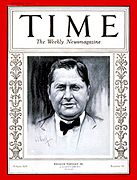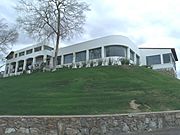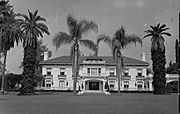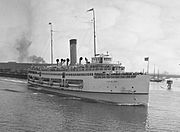William Wrigley Jr. facts for kids
Quick facts for kids
William M. Wrigley Jr.
|
|
|---|---|
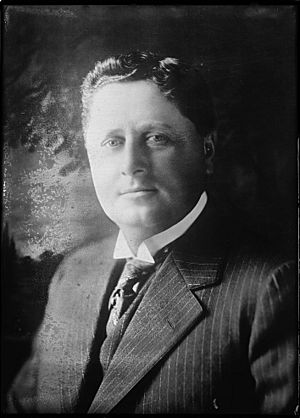 |
|
| Born | September 30, 1861 Philadelphia, Pennsylvania, United States
|
| Died | January 26, 1932 (aged 70) |
| Resting place | Forest Lawn Memorial Park, Glendale, California |
| Occupation | Confectionery magnate |
| Spouse(s) | Ada Elizabeth Foote |
| Children | Dorothy, Philip Knight Wrigley |
| Parent(s) | William and Mary A. Ladley |
| Signature | |
 |
|
William Mills Wrigley Jr. (born September 30, 1861 – died January 26, 1932) was an American businessman. He became famous for making and selling chewing gum. He started the Wm. Wrigley Jr. Company in 1891.
Contents
William Wrigley Jr.'s Early Life and Business Journey
William Mills Wrigley Jr. was born in Philadelphia, Pennsylvania. This was on September 30, 1861. His family were Quakers and had English roots.
In 1891, Wrigley moved from Philadelphia to Chicago. He wanted to start his own business. He began by selling a product called Wrigley's Scouring Soap. To get people to buy his soap, he gave them small gifts, like baking powder.
He soon noticed that customers liked the baking powder more than his soap! So, Wrigley changed his business. He started selling baking powder instead. For every can of baking powder, he gave customers two packages of chewing gum.
Again, Wrigley found that the free gift was more popular than the main product. People loved the chewing gum! This made him realize that chewing gum was a great business idea. His company then focused on making and selling chewing gum. This is how Wrigley became very successful and made his fortune.
Developing Santa Catalina Island
Wrigley played a big part in developing Santa Catalina Island. This island is off the coast of Long Beach, California. He bought a large share of the Santa Catalina Island Company in 1919. This purchase also gave him ownership of the island itself.
Wrigley worked to improve the island for everyone. He added public services and new steamships to help people travel. He also built a hotel and the famous Casino building. He planted many trees, shrubs, and flowers to make the island beautiful.
He also wanted to create jobs for the people living on the island. In 1927, he opened a quarry and tile plant at Pebbly Beach. This plant used clay and minerals found on the island. It provided jobs and also supplied materials for Wrigley's building projects. After building the Avalon Casino in 1929, the plant started making glazed tiles and other items.
One of Wrigley's most important ideas was to protect Catalina Island. He wanted it to be enjoyed by future generations. In 1972, his son, Philip K. Wrigley, created the Catalina Island Conservancy. This group helps protect the island's natural beauty. The family then gave all their ownership of the island to this conservancy. There is a special memorial for Wrigley in the Wrigley Botanical Gardens on the island.
The Wrigley area in Long Beach, California is named after him.
Wrigley and Baseball
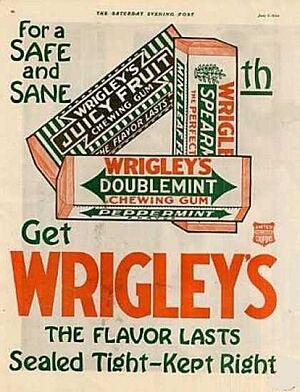
In 1916, Wrigley bought a small part of the Chicago Cubs baseball team. He slowly bought more and more shares of the team. By 1921, Wrigley owned most of the Chicago Cubs.
The Cubs' home ballpark in Chicago was renamed Wrigley Field in 1926. It is still called Wrigley Field today. Another baseball field, the former home of the Los Angeles Angels, was also called Wrigley Field. This team was a "farm team" for the Cubs.
Helping Others
In 1930, Wrigley let the Salvation Army use one of his factory buildings in Chicago. They used it as a place for people who didn't have jobs to stay. The next year, he gave the building to the Salvation Army completely. It was later renamed Wrigley Lodge.
Wrigley also owned the Arizona Biltmore Hotel in Phoenix, Arizona. He built a smaller home nearby called the Wrigley Mansion. This was his winter home, finished in 1931.
William Wrigley Jr.'s Death and Legacy
William Wrigley Jr. passed away on January 26, 1932, at his home in Phoenix. He was 70 years old. He died due to health issues.
He was first buried on Catalina Island, near the Wrigley Memorial & Botanical Gardens. Later, his remains were moved to Forest Lawn Memorial Park Cemetery in Glendale, California.
Wrigley left his money to his daughter Dorothy and his son Philip K. Wrigley. His son continued to run the Wrigley Company until he passed away in 1977.
His great-grandson, William Wrigley Jr. II, is now a leader at the Wrigley Company. In 2000, William Wrigley Jr. was honored by being added to the Junior Achievement U.S. Business Hall of Fame.
Gallery
- William Wrigley Jr.
-
The former Wrigley Mansion in Pasadena, California, now used by the Tournament of Roses Parade.
-
Wrigley's steamship the Catalina leaving the Los Angeles docks in 1924.
See also
 In Spanish: William Wrigley Jr. para niños
In Spanish: William Wrigley Jr. para niños


